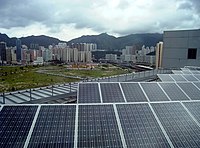
Photo from wikipedia
Abstract Land use change can greatly affect the carbon balance for both terrestrial ecosystems and anthropogenic carbon emissions. However, “physical-social” integrated carbon balance examinations and the link to multiangle land… Click to show full abstract
Abstract Land use change can greatly affect the carbon balance for both terrestrial ecosystems and anthropogenic carbon emissions. However, “physical-social” integrated carbon balance examinations and the link to multiangle land use change analysis are still lacking. Based on land use data, field observations, climate data, and socioeconomic data, this study performed a comprehensive analysis of land use change from the aspects of land use type, land cover and land use intensity and examined the effect on carbon storage, the net ecosystem productivity (NEP) and energy consumption-related carbon emissions. Finally, this study proposed multiangle land use strategies for low-carbon development. The results show that built-up land occupation of cropland was the main land use type change pattern in Nanjing City. The period of 2005–2010 presented the most obvious land use type change. Between 2000–2015, vegetation carbon storage loss reached 8.21×104 t, with woodland shrinkage contributing the most. The initial core city and the peripheral area show the most obvious land use type changes, with decreases in the Normalized Difference Vegetation Index (NDVI) and NEP. For all of Nanjing City, the NDVI followed a weak increasing trend from 2000 to 2015, and the NEP also exhibited a weak increasing trend for areas without built-up land and water. Spatially, the NDVI and NEP present similar changing trends for most grids. Land use intensities were continuously increasing, and energy-related carbon emissions increased from 4389.35×104 t in 2000 to 10145.09×104 t in 2015, with the industry sector contributing more than 80% of the total carbon emissions. In total, NEP accumulation can offset 2% of energy-related carbon emissions. Low-carbon land management should be strengthened from multi-land use aspects, including urban expansion control, ecological land protection, and land use efficiency.
Journal Title: Land Use Policy
Year Published: 2019
Link to full text (if available)
Share on Social Media: Sign Up to like & get
recommendations!